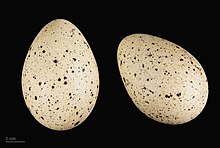Red-knobbed coot
| Red-knobbed coot | |
|---|---|

| |

| |
| Adult birds in South Africa | |
| Scientific classification | |
| Domain: | Eukaryota |
| Kingdom: | Animalia |
| Phylum: | Chordata |
| Class: | Aves |
| Order: | Gruiformes |
| Family: | Rallidae |
| Genus: | Fulica |
| Species: | F. cristata
|
| Binomial name | |
| Fulica cristata Gmelin, JF, 1789
| |
The red-knobbed coot or crested coot, (Fulica cristata), is a member of the rail and crake
It is a resident breeder across much of Africa and in southernmost Spain on freshwater lakes and ponds. It builds a nest of dead reeds near the water's edge or more commonly afloat, laying about 7 eggs (or more in good conditions).[2]
Taxonomy
The red-knobbed coot was
Description


The red-knobbed coot is largely black except for the white frontal shield. It is 35–42 cm (14–17 in) long, spans 75–85 cm (30–33 in) across the wings. Males weigh 770–910 g (27–32 oz), females are slightly smaller and weigh 455–790 g (16.0–27.9 oz). The sexes are alike. As a swimming species, it has partial webbing on its long strong toes. The juvenile is paler than the adult, has a whitish breast, and lacks the facial shield; the adult's black plumage develops when about 3–4 months old, but the white shield is only fully developed at about one year old, some time later.[10]
A good view is necessary to separate this species from the Eurasian coot, with which its range overlaps in northwestern Africa and southern Iberia. There are two tiny red knobs at the top of the facial shield, which are not visible at any great distance and are only present in the breeding season; the black feathering between the shield and the bill is rounded, whereas in Eurasian it comes to a point; and the bill has a bluish grey tinge. In flight, the red-knobbed coot lacks the white trailing edge to the secondaries of the Eurasian coot.[10]
Behaviour



The habits of the red-knobbed coot are practically identical to those of the Eurasian coot. It is much less secretive than most of the rail family. Where it is undisturbed it is likely to bully any intruder, even large birds such as
The red-knobbed coot is reluctant to fly and when taking off runs across the water surface with much splashing. It does the same, but without actually flying, when travelling a short distance at speed (to escape a rival, for example, or to dispute possession of a choice morsel). It bobs its head as it swims, and makes short dives from a little jump.
Breeding
The nest is a bulky platform of reeds and plant stems placed in shallow water. It is built by both sexes. The clutch of 5–7 eggs are laid at daily intervals. The eggs are incubated by both sexes for 18–25 days and hatch asynchronously. The downy
Food and feeding
The red-knobbed coot is an omnivore, and will take a variety of small live prey including the eggs of other water birds. Its main food in most waters however comprises various waterweeds such as species of Potamogeton for which it commonly dives.[11]
This is a noisy bird during mating, but its vocalisations are quite different from the Eurasian coot. It gives a fast kerrre like the little crake, a harsh ka-haa and a grunting hoot "oot oot" that suggests that the name "coot" might be onomatopoeia, but inspection of the etymology of "coot" fairly decisively negates any such suggestion.[12]
References
- . Retrieved 11 November 2021.
- ^ ISBN 978-1-874851-01-1
- ^ Gmelin, Johann Friedrich (1789). Systema naturae per regna tria naturae : secundum classes, ordines, genera, species, cum characteribus, differentiis, synonymis, locis (in Latin). Vol. 1, Part 2 (13th ed.). Lipsiae [Leipzig]: Georg. Emanuel. Beer. p. 704.
- ^ Buffon, Georges-Louis Leclerc de (1781). "Le grande foulque à crête". Histoire Naturelle des Oiseaux (in French). Vol. 8. Paris: De l'Imprimerie Royale. p. 222.
- Daubenton, Louis-Jean-Marie (1765–1783). "Foulque de Madagascar". Planches Enluminées D'Histoire Naturelle. Vol. 8. Paris: De L'Imprimerie Royale. Plate 797.
- ^ Latham, John (1785). A General Synopsis of Birds. Vol. 3, Part 1. London: Printed for Leigh and Sotheby. p. 278; Plate 90.
- ^ Linnaeus, Carl (1758). Systema Naturae per regna tria naturae, secundum classes, ordines, genera, species, cum characteribus, differentiis, synonymis, locis (in Latin). Vol. 1 (10th ed.). Holmiae (Stockholm): Laurentii Salvii. p. 152.
- ISBN 978-1-4081-2501-4.
- Rasmussen, Pamela, eds. (August 2022). "Flufftails, finfoots, rails, trumpeters, cranes, limpkin". IOC World Bird List Version 12.2. International Ornithologists' Union. Retrieved 12 October 2022.
- ^ ISBN 978-84-87334-20-7.
- ISBN 978-1-85368-037-3
- ISBN 0-19-860575-7.
Sources
- Rails by Taylor and van Perlo, ISBN 90-74345-20-4
- Forsman, Dick (1991) Aspects of identification of Crested Coot Dutch Birding13(4): 121-25
External links
- Red-knobbed coot - Species text in The Atlas of Southern African Birds
- Red-knobbed coot videos, photos & sounds on the Internet Bird Collection

